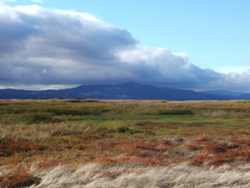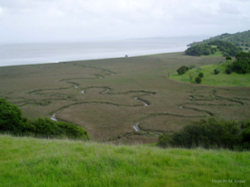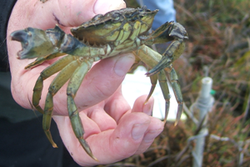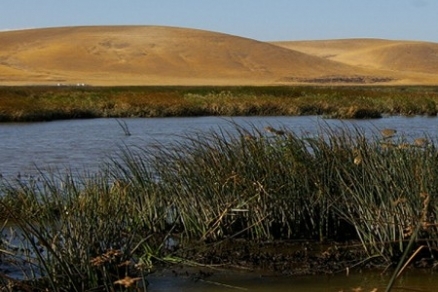San Francisco Bay National Estuarine Research Reserve, California
Contents
- 1 Introduction The primary focus of the San Francisco Bay National Estuarine Research Reserve is to support tidal marsh restoration through research, monitoring (San Francisco Bay National Estuarine Research Reserve, California) and education. It is a reserve within the National Estuarine Research Reserve System, a network of estuarine habitats protected and managed for the purposes of long-term research, education, and coastal stewardship.
- 2 Reserve Sites
- 3 Research
- 4 Further Reading
Introduction The primary focus of the San Francisco Bay National Estuarine Research Reserve is to support tidal marsh restoration through research, monitoring (San Francisco Bay National Estuarine Research Reserve, California) and education. It is a reserve within the National Estuarine Research Reserve System, a network of estuarine habitats protected and managed for the purposes of long-term research, education, and coastal stewardship.
San Francisco Bay has lost nearly 97 percent of its historic tidal wetlands due to development pressures within and around the bay. Tidal wetlands are critical for flood prevention; sediment management; and habitat for small mammals, migratory birds and fish species, many of which are threatened and endangered.
Since 1999, approximately 11,420 acres of wetlands have been restored to tidal influence in San Francisco Bay. Plans for restoring 25,500 acres are underway. However, the effectiveness of restoration can only be measured relative to the remaining 3 percent of relict tidal wetlands. The two reserve components are highly utilized as reference sites against which enhanced, restored or created wetlands are evaluated. The value of these reference sites, coupled with the monitoring, research and education programs sponsored by the National Estuarine Research Reserve System, create an opportunity for agencies to direct research priorities and benefit from scientific studies addressing key restoration issues in the bay area.
Reserve Sites
Rush Ranch Open Space Preserve
 Rush Ranch. (Source: NERRS)
Rush Ranch. (Source: NERRS) Rush Ranch is part of the largest and most intact brackish tidal marsh system in the entire San Francisco estuary, Suisun Marsh. The brackish tidal marsh at this site is exceptionally rich in vegetation and wildlife and is surrounded by undeveloped grasslands and other protected marshes. Visit Rush Ranch to experience the estuary as it was when the Native Americans used it for food and travel.
The preserve is located on the northern margin of Suisun Marsh and is 2,070 acres (1,050 acres of brackish tidal wetlands (old high-elevation marsh), 940 acres of grassland, seasonal systems, springs and ponds, and an 80-acre managed wetland) in size. It was purchased in 1988 by the Solano Land Trust through funding provided by the California State Coastal Conservancy.
China Camp State Park
 View from Turtle Back Hill at China Camp. (Source: NERRS)
View from Turtle Back Hill at China Camp. (Source: NERRS) China Camp State Park is a rare undeveloped piece of land along San Francisco Bay's urbanized shoreline that is a haven for wildlife and for people seeking adventure or a scenic spot for a picnic. These marshes are also essential to the restoration of the Bay's other wetlands: scientists use the marshes here as the reference from which to judge the health of newly restored or created marshes. Visit China Camp to see beautiful examples of a habitat that was virtually eliminated around the Bay but that is now being slowly restored.
The park is located on the southwest shore of San Pablo Bay and measure 1,640 acres in size, which includes wetlands and surrounding uplands. The site became part of the California State Park System in 1978
Research
 European green crab (Carcinus maenas). (Source: NERRS)
European green crab (Carcinus maenas). (Source: NERRS) The San Francisco Bay NERR serves as a living laboratory for on-site staff, visiting scientists and graduate students. Since the inception of the nationwide NERR System, a main goal of the program has been to ensure a stable environment for research through long-term protection of reserve system resources. The reserves serve as platforms for long-term research and monitoring, as well as reference sites for comparative studies.
In addition to participating in the System-wide Monitoring Program and the Graduate Research Fellowship program, the reserve hosts a variety of research projects. The diverse topics include seagrass restoration, habitat mapping and change, channel geomorphology, and the impacts of invasive species.
The reserves also have a partnership with the Cooperative Institute for Coastal and Environmental Technology (CICEET). Many academic researchers conducting research in the reserve system are supported by CICEET. Current CICEET-sponsored projects range from restoring eelgrass habitat to developing technologies to monitor nutrients. In addition, researchers from universities and other institutions are engaged in research projects within the reserve system on topics such as nutrient loading and invasive species restoration.
System Wide Monitoring Program (SWMP)
The National Estuarine Research Reserve System developed a nationwide monitoring program to explore how natural events and human activities affect the health of coastal ecosystems. As part of this program four automated instruments, called dataloggers, will be permanently deployed at SF Bay NERR sites. The dataloggers will measure and record water level, temperature, salinity, dissolved oxygen, pH, and water clarity (turbidity) every fifteen minutes. These data will be used by scientists to monitor short- and long-term changes of the water chemistry. The dataloggers are a central part of a larger monitoring effort that also includes a weather station and biomonitoring programs.
Further Reading
| Disclaimer: This article is taken wholly from, or contains information that was originally published by, the National Oceanic and Atmospheric Administration. Topic editors and authors for the Encyclopedia of Earth may have edited its content or added new information. The use of information from the National Oceanic and Atmospheric Administration should not be construed as support for or endorsement by that organization for any new information added by EoE personnel, or for any editing of the original content. |
